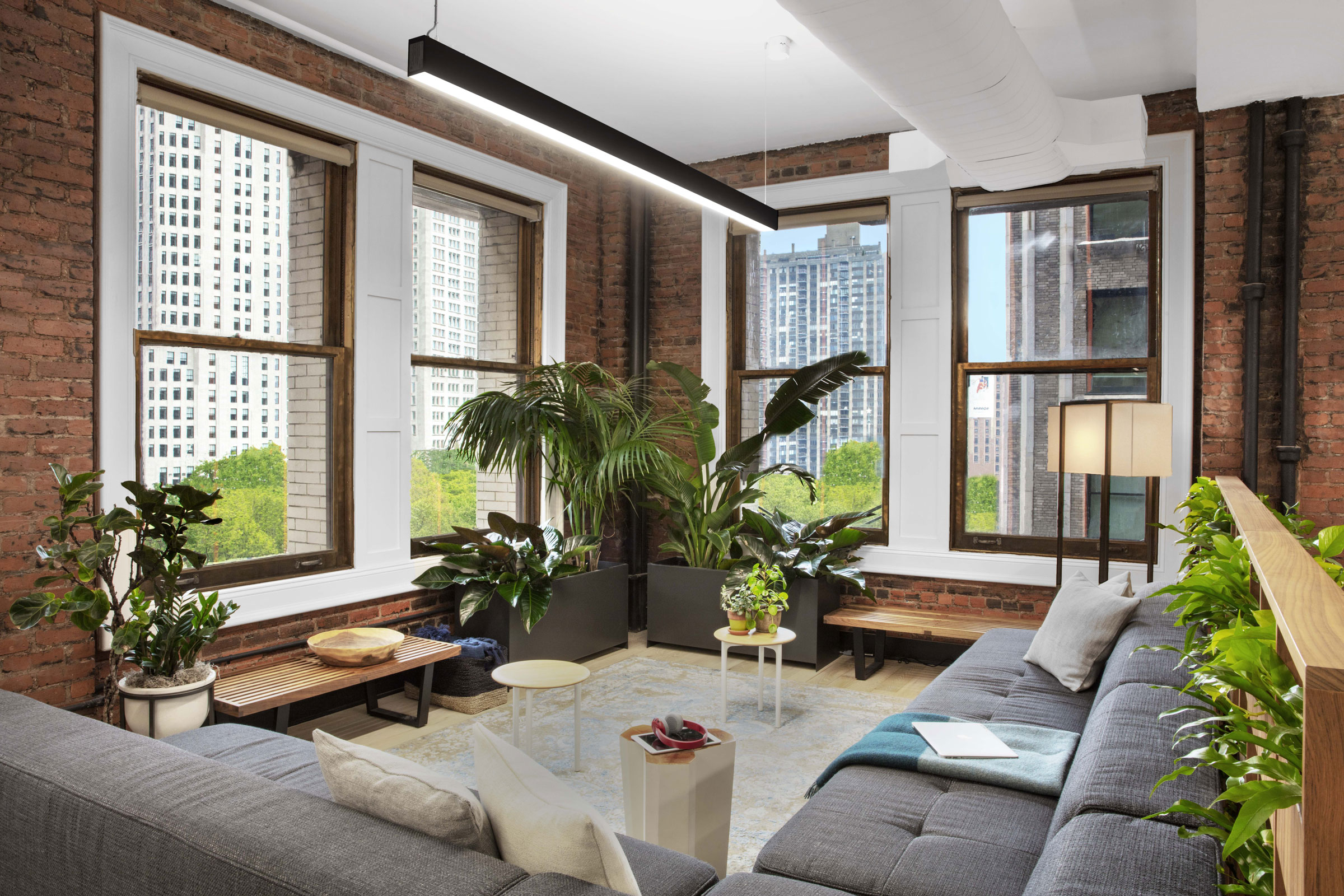Story at a glance:
- Indoor plants are an integral component of biophilic design and can help to liven up a space, but they also offer a few other surprising benefits.
- Studies suggest that the presence of potted plants in indoor spaces can help reduce stress levels, improve mood, increase productivity, and even reduce patient recovery times in health care facilities.
- Living walls are one way to efficiently introduce a large amount of plants into an indoor space.
Biophilic design is an increasingly popular practice undertaken by architects and interior designers to bring people closer to nature to promote the health of both the environment and people. Companies like Sagegreenlife define biophilic design as an architectural framework that weaves the patterns and forms of nature into the built environment to strengthen connections between humans and nature. As a design term, we know from working with Ambius that biophilic design has only been around since Edward O. Wilson’s 1984 publication Biophilia, but the innate desire for getting back to nature has existed for a long time.
Consider the common preference of being seated at a window when dining in a restaurant, or the unyielding pleasure experienced from sunlight streaming through a window. These are just a couple of the signs showing how biophilic design is at the core of our architectural needs, according to Amanda Sturgeon, CEO of the International Living Future Institute (ILFI).
Plenty of tangible evidence points to how people experience a better physical sense of well-being, lower cholesterol, and lower turnover rates in the workplace with the inclusion of biophilic design. And while biophilic design may be implemented in many diverse ways, it need not be an inherently complex or daunting task; in fact, anyone can adopt biophilic design strategies to enhance personal and environmental health indoors—all you need is a few plants.
Potential Benefits of Indoor Plants
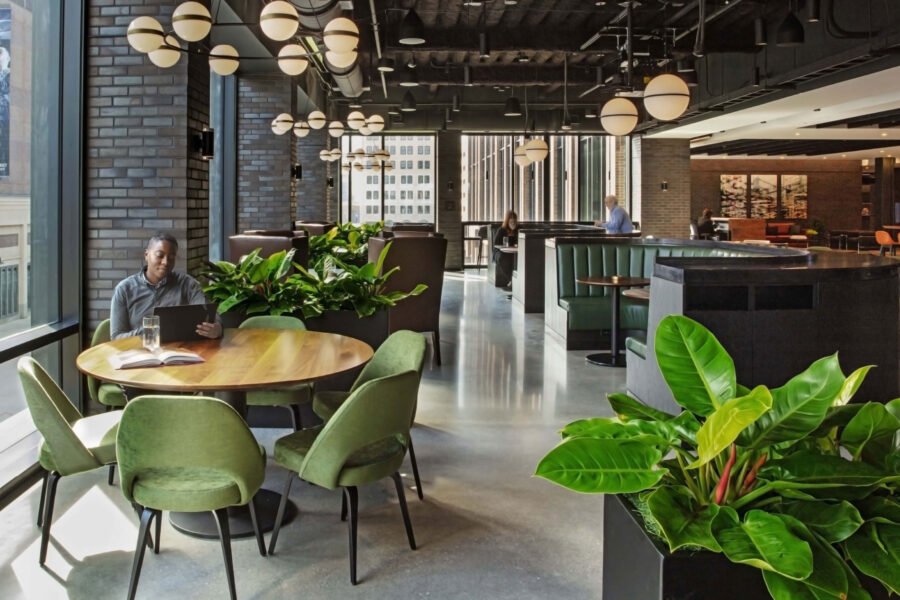
Indoor plants can help reduce stress, improve mood, increase productivity, enhance creativity, and more. Photo courtesy of Ambius
Studies show adding plants to the home or workplace can have positive physiological effects, including reduced stress and increased productivity, according to Kenneth Freeman, the head of innovation at Ambius, a prominent company in sustainable commercial interior and exterior design.
Reduced Stress & Anxiety
According to research conducted by experts at the Texas A&M Department of Horticultural Sciences, looking at plants and other biophilic stimuli can help to lower the body’s cortisol (the hormone that regulates stress) levels. Because they are capable of reducing stress, potted plants have the potential to combat anxiety, depression, and other mood disorders, leading to improved mood and greater life satisfaction.
And while data suggests that simply being in the same room as potted plants is enough to begin lowering stress levels, actively interacting with indoor plants—e.g. watering, pruning, transplanting, et cetera—can also help to lower one’s heart rate and blood pressure. The positive impact of plants on mental health is so great, in fact, that some doctors in the UK have taken to prescribing houseplants as a supplementary means of managing anxiety, depression, and loneliness.
Increased Productivity
Beyond improving mood, studies suggest that indoor plants can also help to increase productivity by improving concentration and reducing mental fatigue recovery time, making them ideal for use in offices and educational facilities. Plants have also been linked to improvements in memory retention and overall cognitive performance.
Plants can also help to increase productivity by stimulating and enhancing creativity. A 2004 study conducted by Japan’s Bunkyo Gakuin University, for example, found that, when asked to make creative word associations, participants performed better when a potted plant was in the same room as them.
Improved Pain Management & Faster Recovery Times
Research also suggests that plants can have a positive impact on the health and recovery times of patients in health care facilities. A 2009 study found that patients recovering in hospital rooms containing ornamental plants had lower systolic blood pressure and lower ratings of pain and fatigue than patients in similar rooms without plants.
By helping to reduce stress, pain, and fatigue, plants also have the potential to speed up recovery times and reduce hospital stays.
Potted Plants to Improve Your Space

Photo courtesy of Ambius
Scientific research suggests that vegetation and greenery in general has a positive effect on the brain, but that doesn’t mean all plants are ideal for indoor use. Some species, like orchids, can be difficult to properly care for, while others may be wholly or partially toxic to pets and small children, in which case they may actually become stressors themselves. Flowering plants, while aesthetically pleasing, introduce pollen into the air, potentially leading to worsened IAQ.
That’s why, as a general rule, non-flowering species with large leaves are the best options to consider when choosing indoor plants. Below are some of the most versatile potted plants to consider when renovating an indoor space:
- Pothos (Epipremnum aureum). Often considered to be one of the easiest indoor plants to care for, pothos is extremely low-maintenance and is capable of tolerating a wide range of lighting conditions; as a vining plant, pothos can help add depth to a space when hung from the ceiling or placed on high shelves thanks to their long trailing stems.
- Snake Plant (Dracaena trifasciata). The Dracaena genus is home to about 40 species, with the snake plant being one of the most popular; these low-maintenance plants prefer indirect light and mild room temperatures, which make them great indoors—just keep in mind that they are considered toxic to cats and dogs.
- Weeping Fig (Ficus benjamina). While originally from the southeastern region of the world, these plants make for a great indoor companion as long as they aren’t overwatered and kept around 65℉; the weeping fig is generally considered easy to care for, though it requires bright, indirect sunlight and is sensitive to sudden environmental changes.
- Bamboo Palm (Chamaedorea seifrizii). Native to Central and South America, the bamboo palm prefers medium temperatures, making it a great indoor option; these plants do not require bright sunlight and can tolerate low to medium light conditions, though they do require consistently moist soil.
- Broadleaf Lady Palm (Rhapis excelsa). Indigenous to Japan and the southern regions of China, the lady palm is a smaller species of palm that’s often considered elegant in appearance; like others on this list, the lady palm requires indirect sunlight, tolerates moderate watering, and is generally considered easy to take care of.
Even those who don’t have much of a green thumb can still incorporate indoor greenery by choosing lower-maintenance varieties like succulents and air plants that require comparatively less attention. Air plants—which make up the Tillandsia genus—encompass some 650 species of evergreen, perennial epiphytes, or plants that do not require soil to grow and develop.
Instead of using their roots to absorb water and nutrients, air plants have tiny, hair-like growths called trichomes on their leaves that trap airborne moisture and dust. Of course, that’s not to say that air plants don’t require watering—indeed, they should be misted two to three times a week or left to soak in water for 25 minutes once a week—though they are considered to be extremely low maintenance. Air plants thrive in humid environments, making them well-suited to bathrooms and other spaces that produce steam.
When Should I Incorporate a Green Wall?
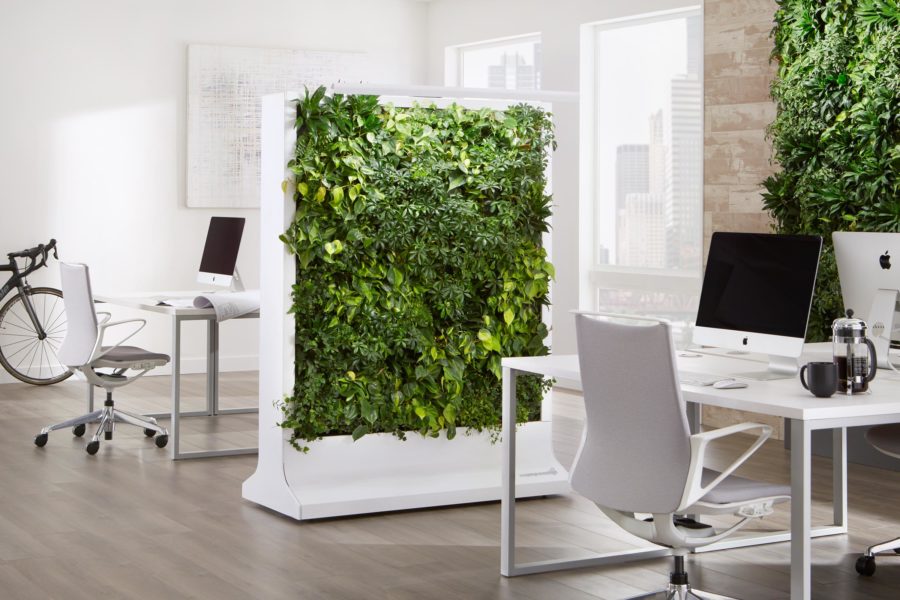
SageGreenLife is known for its biophilic solutions, which bring life into various spaces like the workplace or home. Photo courtesy of SageGreenLife and Steelcase
If you’re looking to do even more in your space, consider green, or “living,” walls. Companies like Ambius and SageGreenLife are leaders in biophilic design and offer services to convert an entire wall space into an indoor plant sanctuary, also known as vertical gardens, living walls, or eco walls. Green walls can help businesses achieve LEED certification.
At SageGreenLife the green wall process begins with mineral wool-based Biotiles. The stone fibers help to secure the root and increase the plants’ life expectancy. When the Biotiles are ready, they are mounted to a panel box with support beams, drainage, and a waterproof backing. Some green walls have self-watering technology, while others require manual watering.
Green walls have unique advantages due to their high plant capacity (up to 16 at SageGreenLife) and the benefit of using typically unused or underutilized wall space in offices or homes. More plants in a smaller vicinity allows them to take in carbon dioxide and toxins at a greater rate than potted plants—though whether living walls are actually capable of noticeably improving IAQ is still up for debate.
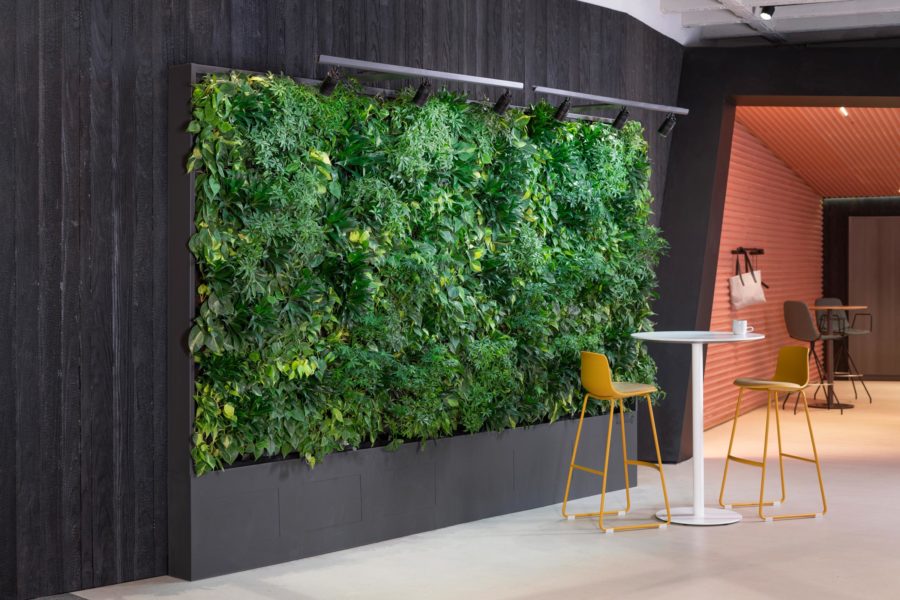
Sagegreenlife’s indoor walls have less than 2% plant loss. Their outdoor walls experience 5 to 7% compared to the industry’s 30 to 50%. Photo courtesy of Steelcase
Green walls, like potted plants, have a variety of plants, which can offer a mix of benefits, too. Dracaena compacta and Creeping Fig plants are options available for selection by SageGreen life for lower lit areas. Some plants are harder to maintain than others—for example, implementing a wall of herbs could cause the wall to become bushy and require more upkeep, according to SageGreenLife COO Darren Mende.
Custom green walls can be made to fit inside any building or home, but they aren’t limited to the indoors. In fact, green walls on building exteriors are great at reducing outside pollution as well. “The biggest way to make a difference and change communities is by integrating these into the built environment inside and outside,” says Mende. When implemented in between buildings, green walls can reduce nitrogen dioxide by 40% and particulate matter by 60%, according to reports from Ambius.
The Truth About Indoor Plants & Air Quality
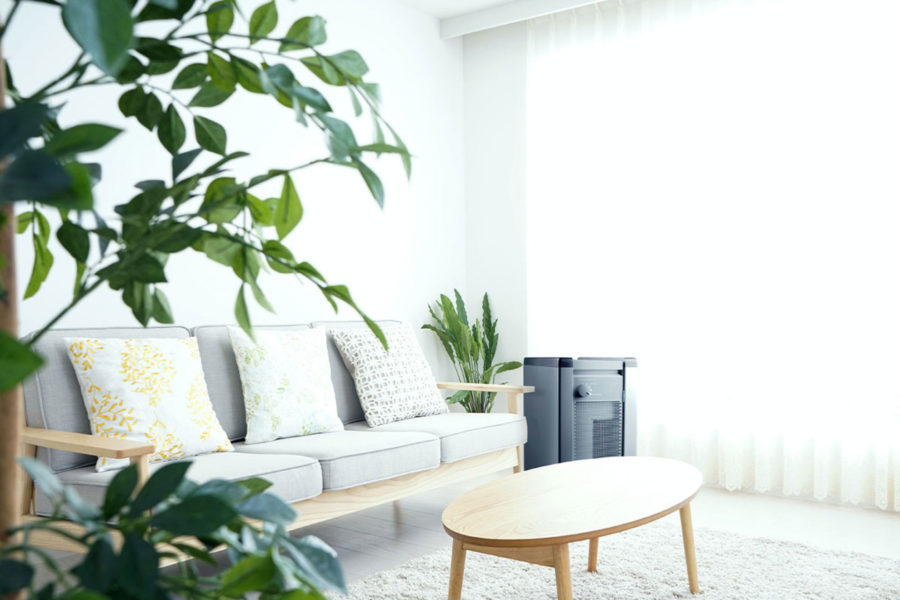
While it’s true that indoor plants absorb trace amounts of VOCs, they are not capable of removing enough pollutants to make a noticeable impact on indoor air quality. The American Lung Association recommends using high-efficiency MERV filters, dedicated outdoor air systems, and air purifiers over plants when it comes to tangibly improving IAQ. Photo courtesy of ActivePure
We should also take a moment to clear up an often-repeated misconception about plants and their effect on indoor air quality (IAQ). Many sites claim that adding a few plants to a space can help improve air quality by removing VOCs and other pollutants from the air—and while this isn’t false, the amount of pollutants a single plant actually absorbs is minuscule. For this reason, current research does not suggest that potted plants are capable of purifying indoor air to a significant degree.
When it comes to removing VOCs and other airborne pollutants from interior spaces, the American Lung Association recommends solutions like high-efficiency MERV filters, dedicated outdoor air systems, and air purifiers, all of which are considered to be much more effective than plants at improving IAQ.
Zoe Seipp contributed to this article.

